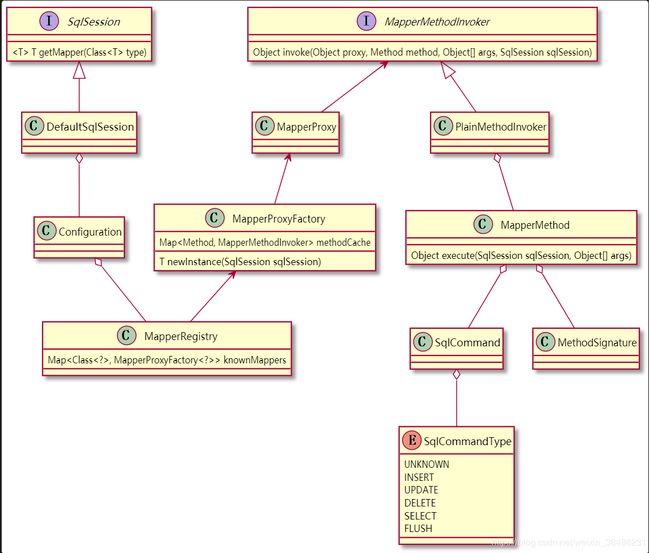mybatis源码分析(1) 如何实现动态代理
文章目录
- 1、mybatis动态代理框架
- 2、动态代理简单介绍
- 3、mybatis动态代理代码实现
- 4、代理方法的注入
1、mybatis动态代理框架
2、动态代理简单介绍
- 通过实现 InvocationHandler 接口创建自己的调用处理器;
- 通过为 Proxy 类指定 ClassLoader 对象和一组 interface 来创建动态代理类;
- 通过反射机制获得动态代理类的构造函数,其唯一参数类型是调用处理器接口类型;
- 通过构造函数创建动态代理类实例,构造时调用处理器对象作为参数被传入。
这边有一篇博文很好的介绍了动态代理如何使用:点此跳转
3、mybatis动态代理代码实现
我们一般调用时会使用
UserDao mapper = session.getMapper(UserDao.class); 因为SqlSesseion为接口,默认的SqlSession结构的实现是DefaultSqlSession
这时我们看到了实际上是调用的DefaultSqlSession类的getMapper函数。DefaultSqlSession类的getMapper函数很简短,实际上也只是做了一层封装,实际是在Configuration类中实现
public <T> T getMapper(Class<T> type) {
return configuration.getMapper(type, this);
}
我们继续看到Configuration类,同样也是做了一层封装,实现在MapperRegistry类中,并且在Configuration类中已经传入了当前的sqlSession,这样对于不同的sqlSession可以进行维度分离
public <T> T getMapper(Class<T> type, SqlSession sqlSession) {
return mapperRegistry.getMapper(type, sqlSession);
}
继续深入进入来到MapperRegistry,这一层的函数中出现了MapperProxyFactory类,这时MapperProxy的生产工厂类,而MapperProxy就是我们所要关注的代理类
public <T> T getMapper(Class<T> type, SqlSession sqlSession) {
//在一开始我们利用XMLConfigBuild类读取配置信息时会将一个class
//和生成一个MapperProxyFactory一起放入knownMappers的map表中
//这样我们对于每一个dao层的类,都有一个MapperProxyFactory来对应他
final MapperProxyFactory<T> mapperProxyFactory = (MapperProxyFactory<T>) knownMappers.get(type);
if (mapperProxyFactory == null) {
throw new BindingException("Type " + type + " is not known to the MapperRegistry.");
}
try {
//最需要关注的函数,这个函数会生成一个代理对象
//我们最终可以通过这个返回的代理对象来进行操作
return mapperProxyFactory.newInstance(sqlSession);
} catch (Exception e) {
throw new BindingException("Error getting mapper instance. Cause: " + e, e);
}
}
正如mapperProxyFactory.newInstance(sqlSession)是最需要关注的函数,他在函数会传入sqlSession环境,同样对不同sqlSession做出了区分。接下来我们来看下这个函数的实现
public T newInstance(SqlSession sqlSession) {
//根据传入信息生成一个代理对象
final MapperProxy<T> mapperProxy = new MapperProxy<>(sqlSession, mapperInterface, methodCache);
return newInstance(mapperProxy);
}
public MapperProxy(SqlSession sqlSession, Class<T> mapperInterface, Map<Method, MapperMethodInvoker> methodCache) {
this.sqlSession = sqlSession;
this.mapperInterface = mapperInterface;
this.methodCache = methodCache; //具体方法实现的缓存
}
protected T newInstance(MapperProxy<T> mapperProxy) {
return (T) Proxy.newProxyInstance(mapperInterface.getClassLoader(), new Class[] { mapperInterface }, mapperProxy);
}
利用上面三个函数就是生成了一个代理对象,这里相信一定会有疑问,这边还没进行委托类的委托类实现的绑定,利用methodCache这个一开始为空的,这样我们应该怎么找到一个方法的实现呢?
4、代理方法的注入
利用代理的性质,我们在外部调用接口函数的时候,具体会走到代理类的invoke函数,我们看到Proxy.newProxyInstance中传入了mapperProxy这个代理类,那么就会调用这个类的invoke函数
@Override
public Object invoke(Object proxy, Method method, Object[] args) throws Throwable {
try {
//如果是一般的函数,可以直接调用
if (Object.class.equals(method.getDeclaringClass())) {
return method.invoke(this, args);
} else {
//调用特定的函数,首先会进入到cachedInvoker(method)中
return cachedInvoker(method).invoke(proxy, method, args, sqlSession);
}
} catch (Throwable t) {
throw ExceptionUtil.unwrapThrowable(t);
}
}
来看下cachedInvoker函数,这个函数会返回具体代理类对象,也就是真正需要进行invoke调用的对象MapperMethodInvoker,
private MapperMethodInvoker cachedInvoker(Method method) throws Throwable {
try {
//这是一个如果没有就添加的函数,
return methodCache.computeIfAbsent(method, m -> {
if (m.isDefault()) {
try {
if (privateLookupInMethod == null) {
return new DefaultMethodInvoker(getMethodHandleJava8(method));
} else {
return new DefaultMethodInvoker(getMethodHandleJava9(method));
}
} catch (IllegalAccessException | InstantiationException | InvocationTargetException
| NoSuchMethodException e) {
throw new RuntimeException(e);
}
} else {
return new PlainMethodInvoker(new MapperMethod(mapperInterface, method, sqlSession.getConfiguration()));
}
});
} catch (RuntimeException re) {
Throwable cause = re.getCause();
throw cause == null ? re : cause;
}
}
但是MapperMethodInvoker也只是一个代理类的接口,具体实现在PlainMethodInvoker上
public Object invoke(Object proxy, Method method, Object[] args, SqlSession sqlSession) throws Throwable {
return mapperMethod.execute(sqlSession, args);
}
PlainMethodInvoker类的invoke函数也会调用MapperMethod的execute函数来执行真正的sql语句。在新建MapperMethod函数时,会根据配置信息创建SqlCommand(用来标识sql语句是什么类型,例如insert,delete,select等)和MethodSignature(这个类中会保存sql的一些数据,例如传入参数的类型,传出参数的类型等),具体sql执行在execute中执行
public Object execute(SqlSession sqlSession, Object[] args) {
Object result;
switch (command.getType()) {
case INSERT: {
Object param = method.convertArgsToSqlCommandParam(args);
result = rowCountResult(sqlSession.insert(command.getName(), param));
break;
}
case UPDATE: {
Object param = method.convertArgsToSqlCommandParam(args);
result = rowCountResult(sqlSession.update(command.getName(), param));
break;
}
case DELETE: {
Object param = method.convertArgsToSqlCommandParam(args);
result = rowCountResult(sqlSession.delete(command.getName(), param));
break;
}
case SELECT:
if (method.returnsVoid() && method.hasResultHandler()) {
executeWithResultHandler(sqlSession, args);
result = null;
} else if (method.returnsMany()) {
result = executeForMany(sqlSession, args);
} else if (method.returnsMap()) {
result = executeForMap(sqlSession, args);
} else if (method.returnsCursor()) {
result = executeForCursor(sqlSession, args);
} else {
Object param = method.convertArgsToSqlCommandParam(args);
result = sqlSession.selectOne(command.getName(), param);
if (method.returnsOptional()
&& (result == null || !method.getReturnType().equals(result.getClass()))) {
result = Optional.ofNullable(result);
}
}
break;
case FLUSH:
result = sqlSession.flushStatements();
break;
default:
throw new BindingException("Unknown execution method for: " + command.getName());
}
if (result == null && method.getReturnType().isPrimitive() && !method.returnsVoid()) {
throw new BindingException("Mapper method '" + command.getName()
+ " attempted to return null from a method with a primitive return type (" + method.getReturnType() + ").");
}
return result;
}
这边sql的执行时通过对应的sqlsession来调用相应的执行器来执行,这边因为篇幅就不细讲了。
这样,我们就可以在xml中定义一个sql语句,然后在dao层创建一个对应的接口,要注意xml中的namespace必须和dao层的全限定地址相同,传入参数传出参数和xml中定义相同,这样我们就只需要定义一个接口,mybatis会自动帮我们进行动态代理来进行调用执行sql语句。
其实动态代理本质上就是讲函数调用在程序运行时才感知到,不会在编译期就知道了,这样有利于程序的复用。
